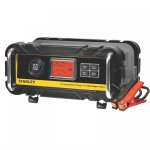From IOTA:
My post probably was confusing because I am saying IOTA does an equalization and I meant to say one way to do them is elevate the voltage while limiting current (primarily not to overheat the battery) for some period of time.
I've measured my IOTA it's closer to 14.9V when it's doing it (again, just based on the blinking LEDs) so the IQ4 tech sheet numbers are not exact. The DLS series has a trim pot but I've never adjusted mine. My understanding is that IQ4 is just switching through resistance values so I'd also expect all my set points to be 0.1V higher than the spec sheet. It's not a highly complex power supply. I don't even think it's even doing digital control TBH.
So is it exactly a desulfation or not? Not sure. Probably not according to the Rand/Mosley definition of the phenomenon. But there's also an argument that if you float properly a battery won't really sulfate that badly anyway, so maybe the IOTA equalization really isn't doing anything and is purely marketing bull. I dunno, not a chemist. If you can call it anything maybe the equalization is just a step through the 3 standard stages periodically to prevent stratification rather than to desulfate. If their engineering is to be believed the 4th stage they call equalization is like bulk but with a current limit.
Truth be told the only way to really do it would require a before, during and after gravity measurement and actively monitoring temperature, voltage and current so anything other than doing it manually is really just a wild *** guess and kind of impossible to verify by inspection on VRLA anyway.
Um yes. Unfortunately, Mr. Bull is, well, somwhat full of bull.
If you look at the specs on Iota chargers, without the IQ/4, they are single stage 13.6v power supplies. Plugging in the dongle turns them into two stage chargers - bulk/float. The bulk voltage is listed as 14.2v, float is still 13.6v.
Add the IQ/4 and it becomes a three stage - bulk/absorb/float. The bulk voltage is bumped up to 14.8v, and the absorb stage of 14.2v is always on an 8 hour timer, then it drops to float at 13.6v.
So what Mr. Bull is describing, is actually the normal default behavior of the IQ/4.
So as I said, every seven days a timer trips and the IQ/4 simply does a run through of its
normal charging profile.
Is it good for the batteries? Once a week push it up to 14.8v and then float it at 14.2v for 8 hours and then float it at 13.6v for another week. No doubt, that's very good for the batteries.
Is that the "timed, controlled overcharge" used to equalize and destratify cells (and which should never be done to VRLA batteries)? Nope, it's just the normal IQ/4 charge profile.
Is it "desulfation"? Nope. Oh sure, keeping the battery fully topped off slows sulfation, and that's good, but not only does the charger not do what is normally considered to be "equalization", it also does not do what is normally considered to be "desulfation".
Still, they are bloody good chargers. One of my all time favorites.
Iota is only guilty of a bit of marketing hype regarding "charging stages". Study the specs on a Progressive Dynamics charger with their "Charge Wizard" and compare that to their marketing hype to see an example of taking the charging stage BS over the top.
The PD is a two stage bulk/float. Then after, I think it's 72 hours or something at float, it drops to a lower float voltage. Pushing the charge wizard button shoves it into bulk stage and starts the process over again.
Their marketing droids call that a 4 stage charger.


